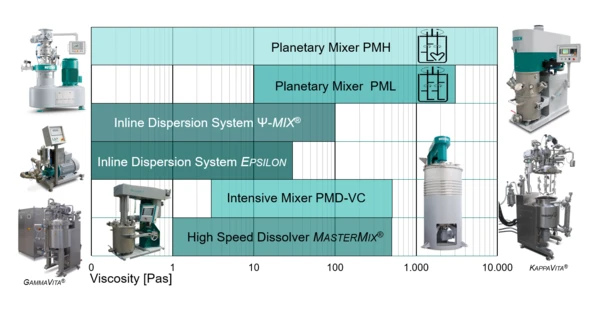Glossary
Viscosity
Viscosity in wet grinding process
In the field of wet comminution in agitator bead mills, suspensions are mainly processed. As comminution progresses, the particle size of the solid components becomes smaller and the specific surface area of the particles becomes larger. This surface is wetted with the liquid dispersion medium (e.g. water, solvent or oil) so that the proportion of freely available liquid decreases. As a rule, this effect increases the viscosity of the suspension.
There are a few important aspects to consider in mixed technology:
In special cases, of deagglomeration processes or disaggregation processes, in which the particles are prevented from moving freely by their particle, agglomerate or aggregate shape, there may be a decrease in viscosity with increasing dispersion success.
The viscosity as well as the rheological behavior of the product suspension influence the grinding media separation, the cooling efficiency and the power input into the grinding chamber in wet grinding processes in agitator bead mills. However, product viscosity should not be used as a parameter to influence the power input.
This means that there is a material-dependent optimum for the solids concentration of the product suspension.
If the solids concentration is too low, grinding media collisions will result without caught and stressed product. This leads to inefficient grinding and increased wear on grinding media and machine parts. Excessively high solids concentrations lead to an increase in viscosity and also to inefficient grinding, because the high viscosity slows down the movement of the grinding media and thus the stress energy acting on the particles is no longer sufficient to crush them.
In addition, due to the increase in viscosity, the product throughput through the grinding chamber is limited. Cooling efficiency is also reduced.
Viscosity in mixing process
The viscosity of a dispersion or a dispersion medium has a decisive influence on the mixing dynamics and the efficiency of the mixing process. The viscosity of a suspension or dispersion depends on its composition, the particle shape of solid components, the temperature and the shear stress, and can vary greatly locally, even in the case of the identical material system.
There are a few important aspects to consider in mixed technology:
- Mixing behavior: Liquids with higher viscosity tend to flow more slowly and are more difficult to mix. They often require stronger or specially adapted mixing tools and higher power inputs.
- Energy requirements: Higher viscosity materials usually require more energy to mix. The design of the mixer as well as the mixing technology need to be adjusted to ensure efficient mixing.
- Homogeneity of the mixture: Achieving a homogeneous mixture can be challenging with high-viscosity materials, as it is more difficult to move all the components in a mixing container without dead space.
- Dispersion of solids: In high-viscosity media, it is usually easier to disperse solids and distribute them homogeneously in the suspension, as the shear forces transmitted by the high-viscosity medium can contribute to deagglomeration. However, if it is essential for the subsequent product properties that the original structure of the solids is preserved (shear-sensitive solids), high viscosity can be problematic too.
- Shear-thinning effect: Some viscous materials exhibit shear thinning behavior in which their viscosity decreases with increased shear stress. This must be taken into account when designing the mixing process.
In the field of mixing technology, it is therefore important to understand the viscosity and rheological behavior of the product and the properties of the materials to be mixed, and to adapt the mixing process accordingly in order to achieve an effective and efficient mixing process.

Viscosity in Classifying Processes in Dry Grinding Technology
In many dry grinding machines, air classifiers with dynamically operating classifier wheels are used as an integral part of the respective machine to control the desired particle size.
Sifting is when a separation into coarse and fine material can be carried out by comparing two forces. The forces are almost always a drag force caused by the flowing fluid (compressed air or supercritical steam) and a centrifugal force, either caused by the Earth's gravitational field or an imprinted rotation. In dynamic air classifiers, this centrifugal force is caused by the rotation of a classifier wheel. The drag force is directly dependent on the viscosity of the flowing fluid.
In the patented s – JET®process, the jet mill is operated with supercritical steam. The higher pressures and temperatures result in almost twice the jet speed. Despite the lower viscosity of the steam, even very small particles can be accelerated to such an speed that sufficient stress energies are transferred for the particle breakage.
The much higher speed of sound in supercritical steam allows for higher classifier speeds. In combination with the lower viscosity and the associated dragging force, fineness in the range between 100 - 200 nm can be achieved with this process.